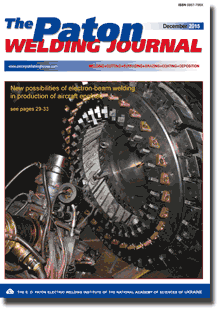| 2015 №12 (01) |
DOI of Article 10.15407/tpwj2015.12.02 |
2015 №12 (03) |

The Paton Welding Journal, 2015, #12, 8-13 pages
Effect of depressants and base metal on microstructure of brazed seams in joints of Ni3Al-based alloys with Inconel 718 alloy
S.V. Maksymova, V.F. Khorunov And V.V. Myasoedov
E.O. Paton Electric Welding Institute, NASU. 11 Bozhenko Str., 03680, Kiev, Ukraine. E-mail: office@paton.kiev.ua
Abstract
Properties of brazed joints are caused by their microstructure. Therefore, metallographic and X-ray microspectral analysis of brazed joints have large importance in selection of composition of brazing filler metal and parameters of technological mode of brazing. Relevance of such investigations rises in development of technological processes for brazing of the joints from materials of new generation, to which nickel alloys based on γ'-Ni3Al intermetallic can be referred. This paper represents the results of metallographic and X-ray microspectral analysis of the brazed joints from heat-resistant nickel alloy based on Ni3Al intermetallic with Inconel 718 grade wrought alloy produced with the Ni-Cr-Fe-B-Si and Ni-Pd-Cr-X(Ge, Co) system brazing filler metals. Effect of depressants, i.e. boron and silicon, on formation of structure in seams is shown. Influence of constituents of material being brazed on composition and morphology of seam is determined. It is found that brazing of Ni3Al-based alloy using Ni-Pd-Cr-X(Ge, Co) brazing filler metal provides for seam structure consisting of solid solution based on nickel and single dispersed phases. The latter are enriched with (Pd, X)Al type aluminum, a concentration of which corresponds to aluminum concentration in the base metal. Their formation takes place due to diffusion processes at interface. Single-phase areas consisting of nickel-based solid solution are observed in the brazed seam. 12 Ref., 6 Tables, 7 Figures.
Keywords: vacuum brazing, heat-resistant Ni3Al-based alloy, microstructure, seam, X-ray microspectral analysis, solid solution, brazing filler metal
Received: 13.10.15
Published: 21.01.16
References
- Khorunov, V.F. (2008) Principles of brazing of thin-wall structures from high-alloy steels. Kiev: Naukova Dumka.
- Radzievsky, V.N., Tkachenko, G.G. (2009) Vacuum brazing in compressor engineering. Kiev: Ekotekhnologiya.
- Khorunov, V.F., Maksymova, S.V. (2013) Brazing of superalloys and the intermetallic alloy (g-TiAl). Advanced in brazing. Science, technology and applications, 85-120. Cambridge: Woodhead Publ.
- Riggs, B., Alexandrov, B., Benatar, A. et al. (2015) Microstructural characterization of single crystal superalloy CMSX-4 brazed joints with BNi-2 and BNi-9 filler metals. IBSC-2015.
- Grinberg, B.A., Ivanov, M.A. (2002) Intermetallics Ni3Al: Microstructure, deformation behavior. Ekaterinburg: UrO RAN.
- Kolobov, Yu.R., Kablov, E.N., Kozlov, E.V. et al. (2008) Structure and properties of intermetallic materials with nanophase strengthening. Moscow: MISiS.
- Rabinkin, A. (2013) Brazing of superalloys and the intermetallic alloy (g-TiAl). Advanced in brazing. Science, technology and applications, 121. Cambridge: Woodhead Publ.
- Maksymova, S.V. (2007) Amorphous braze filler metals for brazing of stainless steel with titanium and structure of brazed joints. Adgeziya Rasplavov i Pajka Materialov, 40, 70-81.
- Malashenko, I.S., Kurenkova, V.V., Belyavin, A.F. et al. (2006) Short-time strength and microstructure of brazed joints of alloy VJL12U produced using boron-containing brazing filler metal with addition of silicon. Advances in Electrometallurgy, 4, 23-38.
- Massalski, T.V. (1990) ASM binary alloy phase diagrams. Metals Park: ASM Int.
- Maksymova, S.V., Khorunov, V.F. (2015) Diffusion processes and formation of structure of brazed joints on titanium aluminides. J. Appl. Phys. Sci. Int., 2(1), 24-29.
- Larikov, L.N., Isajchev, V.I. (1987) Structure and properties of metals and alloys: Refer. Book on diffusion in metals and alloys. Ed. by A.I. Rajchenko. Kiev: Naukova Dumka.
